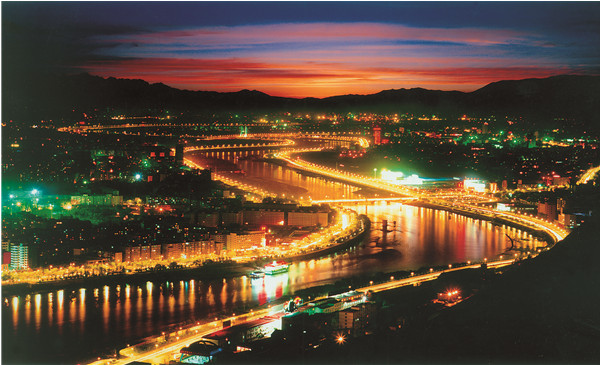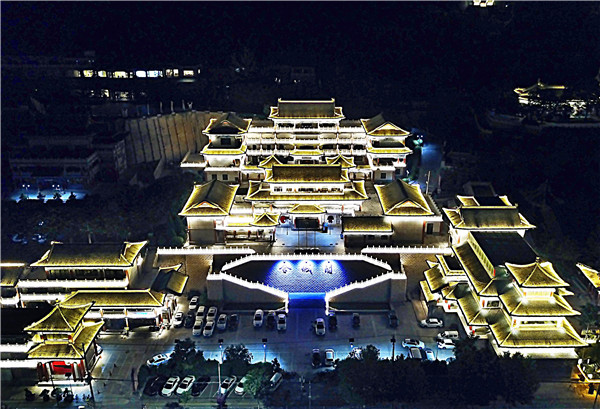Gansu overview
1. Territory, population and topography
Gansu province, referred to as Gan or Long, is located in the upper reaches of the Yellow River in western China, with a total area of 425,900 sq km. There are over 12 prefecture-level cities, two autonomous prefectures and 86 counties (cities and districts included) within its jurisdiction. The provincial capital is Lanzhou city. With a resident population of 24.58 million, Gansu is a multi-ethnic province, where ethnic minorities account for 10.62% of the permanent population. Yugu, Baoan and Dongxiang are ethnic groups unique to Gansu.
The administrative area of Gansu province ranges from 32°31′ to 42°57′ N latitude and from 92°13′ to 108°46′ E longitude. It has a temperate, monsoon-influenced, continental climate with annual temperatures ranging from 0 ℃ to 16 ℃. The altitude varies from 1500 to 3000 meters. Therefore, temperatures vary widely with the sufficient sunshine and the large daily temperature difference. The annual precipitation throughout the province is between 36.6 and 734.9 millimeters, and decreases from southeast to northeast. Affected by monsoon season, precipitation is mostly concentrated in June to August, when it accounts for 50% to 70% of the annual total.
Gansu is located in the intersection of the Loess Plateau, the Qinghai-Tibet Plateau and the Inner Mongolia Plateau. It is a mountainous plateau landform that features crisscrossing mountains and different altitudes. The terrain slopes from the southwest to the northeast with a narrow and long topography, which is 1,655 kilometers long from east to west, and 530 kilometers wide from north to south. It can be roughly divided into six distinctive regions: Longnan Mountain, the Longdong and Longzhong Loess Plateau, the Gannan Plateau, the Hexi Corridor, Qilian Mountain and the north reaches of the Hexi Corridor. Blessed with the Gobi desert, forest steppes, glaciers and snow peaks, Danxia landforms and canyon caves, the natural scenery is magnificent and adds to the province's reputation among geologists as a museum of rich geological and surface features.

2. Resource endowment
Gansu, one of the important birthplaces of the Chinese nation and civilization, is known as "Home to Fuxi and the Yellow Emperor". According to legend, Fuxi, Nvwa and the Yellow Emperor, who are known as the Chinese ancestors, were all born in Gansu. People in the Zhou Dynasty (1046-256 BC) grew up in Qingyang, and people in the Qin Dynasty (221-206 BC) laid the groundwork in Tianshui and Longnan. Gansu province is blessed with abundant resources in terms of historical heritage, classic culture, national folklore and tourism, and ranks fifth in China in that regard. Results of the first survey of portable cultural relics in Gansu province were announced in 2018. The number of its registered cultural relics was 423,444 pieces/sets, and the actual number of cultural relics was 1,958,351, ranking 17th and the 10th in the country respectively. The total number of registered precious relics ranks fifth nationally and the actual number ranks third. Its rich cultural tourism resources make Gansu an internationally well-known tourist destination. In 2017, it ranked first on a Lonely Planet "2017 Best in Asia" list. In 2018, it ranked 17th on a list of 52 places to go in the world by the New York Times, and was the only place selected in China.
Gansu is also one of the birthplaces of traditional Chinese medicine. The Yellow Emperor's Canon of Internal Medicine, written by Qibo, the forefather of the traditional Chinese medicine, and the Classic of Acupuncture and Moxibustion by Huangfu Mi, the ancestor of Acupuncture and Moxibustion, are unique in ancient traditional Chinese medicine. One of the main producing areas of Chinese medicinal materials, Gansu currently has 3,626 types of traditional Chinese medicinal resources, among which 21 varieties account for over 50 percent of the national output. In 2024, the planting area of traditional Chinese medicine in the province reached 354,667 hectares, with a yield of 1.6 million metric tons.
Gansu is rich in minerals, water conservancy, biology, and light and heat resources. It boasts superior ore-forming geological conditions and consequent rich mineral resources. One hundred and eighty kinds of useful minerals have been found, of which 11 minerals, such as nickel, cobalt and platinum have the highest reserves in the country; gold reserves are also tops nationally. Gansu also has various types of energy. In addition to coal, oil and natural gas, it has new energy sources such as solar and wind power. Specifically, the reserves of coal, oil and natural gas rank at the top in the country, and Guazhou city is known as the "World Wind Bank". Gansu is also one of the three regions with the most abundant solar energy in China.
Gansu's primeval forests are located in Bailong River, Tao River, Qilian Mountains, Daxia River and other places. There are more than 4,000 species of wild plants in the forest, and 53 species or subspecies of wild animals are listed as national rare and precious animals, including giant pandas, golden monkeys, musk deer, lynx, mink and others of the world’s precious animals. Gansu is one of the seven provinces with an area of more than 150,000 km2 of natural grassland in China, as well as an important base of stockbreeding.
3. Economic society
In recent years, Gansu has been committed to the two bottom-line tasks of poverty alleviation and ecological development, and promoted progress in poverty alleviation and environmental development. By taking the new development concept as a guide and supply-side structural reform as the main line, Gansu has seized historical opportunities such as Belt and Road Initiative and adopted the Great Western Development Strategy. Moreover, Gansu has adhered to the keynote of seeking progress in stability, and promoted economic and social development steadily and healthily.
The province's total economic output continues to grow. In 2024, its GDP reached 1.3 trillion yuan ($180.21 billion), an increase of 5.8% over the previous year, which is 0.8 percentage points higher than the national growth rate.
Poverty alleviation witnessed decisive progress and historical accomplishments. In 2020, 75 poor counties of Gansu province were lifted out of absolute poverty,creating an all-round moderately prosperous society along with other counties in the nation. Main indicators of poverty alleviation in key areas were fulfilled. The mission that rural area people should be free from worries over food and clothing and have access to compulsory education,basic medical services and safe housing was completed. Four hundred and ninety-four registered poor households were relocated during 13th Five-Year Plan period (2016-2020). It created a huge poverty alleviation pattern due to unified effort from the West and the East, thus promoting social and economic development. At the same time, with the fusion of poverty alleviation and ecological protection, 900 model villages were built under the concept of Beautiful Villages in Gansu province as were 225 Village Tourism model villages. Many poor villages set up tourism sector, therefore, ecological protection was promised and clear waters and green mountaion became as valuable as mountains of gold and silver.
The province's scientific and technological innovation strength keeps improving. Gansu has formed a distinctive technological innovation system. It has 14 national key laboratories, five national engineering technology research centers, 575 various technology research and development platforms, and 665 R & D activity agencies. In 2019, scientific and technological progress contributed 54.03% of Gansu's economic growth. Its scientific and technical innovation ranks 23rd in the nation and 5th in western regions of the country. The output value of the Lanzhou-Baiyin Innovation Demonstration Zone has reached 39.75 billion RMB. The output value of Lanzhou-Baiyin Pilot Free Trade Zone is measured at 90.68 billion RMB. The Cold and Arid Regions Environmental and Engineering Research Institute of the Chinese Academy of Sciences has solved the key technical problems in preventing and controlling freeze-thaw disasters on permafrost roads. The Dunhuang Research Institute has become the leading comprehensive research and research entity for the protection of grottoes cultural relics in the nation. The new breed of "Datong Yak" fills the gap in global yak technology systems.
Cultural tourism develops rapidly. In 2024, Gansu province has welcomed 451 million tourists, with revenue climbing to 345.2 billion yuan, up 15.9 percent and 25.7 percent respectively. New progress has been made in the construction of smart cultural tourism platforms such as "A Mobile Phone Tour in Gansu" and "Traveling the Silk Road with the Treasure Ruyi". A basic block chain platform themed with "Digital Gansu, Glorious Chain" has been launched. Dunhuang City was included among the first national holistic tourism demonstration zones. The parade float named "Symphonic Silk Road, Beautiful Gansu" won the Innovation Award for celebrating the 70th anniversary of the founding of the People's Republic of China. The "Stunning Dunhuang-Cultural Fashion Show was unveiled at the 15th World Chinese Entrepreneurs Convention in London, and the large-scale immersive performance "Musical Dunhuang" was awarded as the Best Tourism Innovation Award in China. The scenic spot of Zhangye Danxia Seven Colored Earth has been promoted to a National 5A Level Scenic Spot, and the Dunhuang Research Institute was selected into the top 10 in the single category of the national demonstration base for the integration of culture, science and technology.
The Belt and Road Initiative has been further advanced. In 2024, the total import and export of Gansu to countries involved in the Belt and Road hit 47.39 billion yuan, up 27.7 percent year-on-year and accounting for 77 percent of its total value of foreign trade. Gansu has sped up the construction of the internal and external interconnection platforms, and has become a hub of the east-west international land bridges and the north-south transport corridors.
The public cultural service system is becoming increasingly perfected. The public cultural service system is advancing vigorously and comprehensively. Cultural activities, such as "Literary Arts Cavalry", "Our Chinese Dream", "Bringing Culture Homes", "Literary Longyuan" "Nationwide Reading", "Science & Technology of Culture and Health", "Volunteer Activities for the Country People" and "Floating Books" have greatly enriched the general public culturally and artistically. In addition, "Baicaoyuan Public Cultural Service Platform Operation Company" has been planned and established. In that way Gansu has taken the lead in building a digital platform for rural bookstores. Baiyin city has been selected among the third batch of the Demonstration Areas of the National Public Cultural Service System. Moreover, the construction of the "Rural Stage" in Kang county, Longnan city, and of "Cultural Associations" in Jingchuan county, Pingliang city was selected into the third batch of Demonstration Projects of the National Public Cultural Service System.
The livelihood and well-being of people have been continuously improved. In 2024, Gansu's 11 types of livelihood expenditures accounted for 80.2 percent of the general public budget expenditures, with the growth rate of per capita disposable income for all residents reaching 6.4 percent, ranking third in the country. The growth rate of per capita disposable income for urban residents hit 5 percent, ranking third in the country. The growth rate of per capita disposable income for rural residents was 7.4 percent, ranking third in the country.

4. Development of ecological civilization
Due to its important ecological status, Gansu province is an ecological safe shelter zone in northwest China and throughout the whole country. In recent years, upholding the principle that "lucid waters and lush mountains are invaluable assets", the whole province has been devoted to making great progress in the construction of ecological civilization. Zhangye city is known as a national ecological civilization demonstration point, and Pingliang city has been awarded as the Virescense Exemplar City of China. BabuSha Forest Farm was named as an innovation and practice base of the pleasant ecological environment by the Ministry of Ecology and Environment. The local advanced group of desertification and afforestation, six senior citizens and their descendants who have been devoted to sand control and afforestation, were named "Models of the Times" by the Publicity Department of the Communist Party of China. Nowadays, a beautiful new Gansu with bluer sky, greener mountains and clearer water is appearing in the world.
